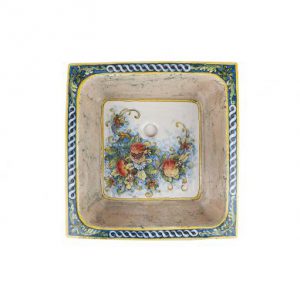For a dozen or so years now, designers have been moving away from the fairly common, standard way of finishing a bathroom with a built-in bath and washbasin attached to the wall. Freestanding bathtubs and countertop washbasins are increasingly used. The classic freestanding bathtub adds prestige and taste to the interior. Following this path, the installation of ceramic artistic washbasins in modern bathrooms is becoming increasingly common. At the last fair in Milan, the futuristic designs of Rubinetterie and Inbani, cabinets for countertop washbasins, made a furore. The furniture took incredible shapes, such as rhombus or polygon, and was made of various materials, including minerals. Such a cabinet was often complemented by
It is ceramics created by artists who give the washbasin its expected form, burn it and glaze it with their own hands. The process of manufacturing such washbasins is extremely difficult, because apart from its aesthetic value, such ceramics must also serve a functional function, so there is no room for imperfections in material or workmanship.
The unquestionable advantage of such a washbasin is its uniqueness. Despite the fact that the artist has a specific pattern, the process of manual creation causes minor deviations from the assumed dimension, shape and colour. Slightly different layer of enamel coating, as well as each time a differently marked grid of cracks created during the firing process, makes such ceramics a work of art. Each time the art washbasins are hand dyed and the patterns placed on them can be very complicated.
Artists making this type of ceramics produce short series, and special orders from interior design offices can wait several months. Often the products of applied artistic ceramics are collector's items and reach very high prices. Having this type of equipment can be a proof of unquestionable taste and an original look at the surrounding space.
Depending on the way they are made, as well as the material they are made of, there are several types of artistic washbasins.
 Hand-shaped washbasins can be symmetrical or asymmetrical in shape. The whole production process is done by hand, starting from shaping the shape, through the application of colour, pattern, to firing and glazing.
Hand-shaped washbasins can be symmetrical or asymmetrical in shape. The whole production process is done by hand, starting from shaping the shape, through the application of colour, pattern, to firing and glazing.
 Onyx washbasins are products made of a mineral that has been considered to be lucky for centuries. Such washbasins can be either geometric or natural in shape. The stone form gives the product an incredible character, and the interior equipped with it gets an extremely impressive and exclusive design. The most popular and known colour of onyx is black, but it is not uncommon to find this mineral in green, white, grey and even yellow.
Onyx washbasins are products made of a mineral that has been considered to be lucky for centuries. Such washbasins can be either geometric or natural in shape. The stone form gives the product an incredible character, and the interior equipped with it gets an extremely impressive and exclusive design. The most popular and known colour of onyx is black, but it is not uncommon to find this mineral in green, white, grey and even yellow.
 Bolesławiec washbasins are made with a unique in the world stamping technique. It combines both functional and decorative features. The tradition in the production of this type of stoneware dates back to the early nineteenth century and is often bought as a collector.
Bolesławiec washbasins are made with a unique in the world stamping technique. It combines both functional and decorative features. The tradition in the production of this type of stoneware dates back to the early nineteenth century and is often bought as a collector.
 Italian washbasins are amazing in form and colour products made in the Italian city of Santo Stefano di Camastra, also known as "City of Ceramics". These luxurious pieces of equipment are produced by craftsmen who transfer their knowledge from father to son. They are made with great care and can satisfy the most demanding customers. The term "work of art" can be used boldly in this case.
Italian washbasins are amazing in form and colour products made in the Italian city of Santo Stefano di Camastra, also known as "City of Ceramics". These luxurious pieces of equipment are produced by craftsmen who transfer their knowledge from father to son. They are made with great care and can satisfy the most demanding customers. The term "work of art" can be used boldly in this case.
 Fossilized wood washbasins are products made of wood which, under the influence of physical and chemical conditions, has turned into stone. In this case, the form of the washbasin was mainly given by nature, and man has only influenced its functional functions.
Fossilized wood washbasins are products made of wood which, under the influence of physical and chemical conditions, has turned into stone. In this case, the form of the washbasin was mainly given by nature, and man has only influenced its functional functions.
 Wash basins made of semi-precious stones are unique elements of small architecture, extremely exclusive and giving the interior a unique charm. Stone as a natural material is a unique composition of patterns and colour combinations, which cannot be achieved with mass production.
Wash basins made of semi-precious stones are unique elements of small architecture, extremely exclusive and giving the interior a unique charm. Stone as a natural material is a unique composition of patterns and colour combinations, which cannot be achieved with mass production.
Artistic washbasins in the Cerames store are offered in a very large selection, and the range sold is mostly available "off-the-shelf".